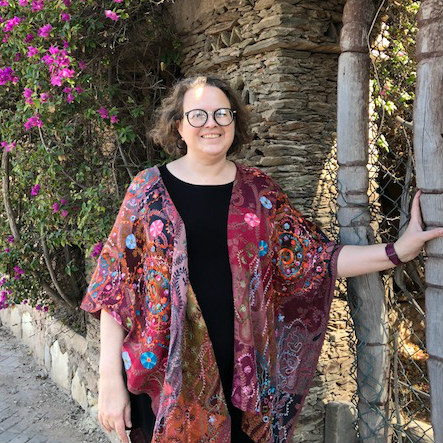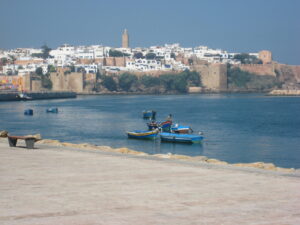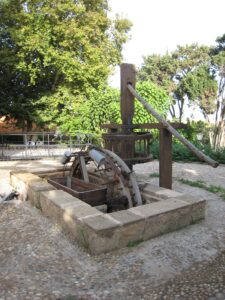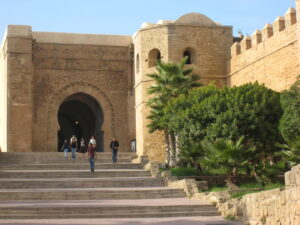Edith Wharton’s Morocco, A Literary Pilgrimage, a guest post by Stacy Holden
Today I’m going to give you a little break from the Great River Road. We’re still going to be on the road, just further afield. Morocco in fact, courtesy of writer, historian and traveler Stacy E. Holden.
Stacy is a history professor at Purdue University. Her published works focus on everyday life in the Arab world as well as Western representations of the Middle East and North Africa. She has written on historic preservation, UNESCO heritage sites, and even post-9/11 romance novels set in imaginary Arab kingdoms. She is now working on a book about how Edith Wharton shaped American attitudes toward the Middle East and North Africa.
I don’t remember who introduced us to each other, but thank you whoever you are. We’ve been talking about history, writing, and travel ever since.
Take it away, Stacy!
In 1917, Edith Wharton traveled to Morocco for five weeks, and three years later she published In Morocco. Even today, her travel account reads like “Top Ten Things To Do in Morocco 2022.”
When Wharton disembarked in Tangier, this North African kingdom had been a French colony for only five years. In Morocco was the first account of colonial rule in Morocco by an American author and for an American audience. This information is key to understanding the importance of this book. Wharton backs French colonial rule, even though the US, first under Republican President William Howard Taft and then Democrat Woodrow Wilson opposed France’s imperial expansion.
Wharton was an official guest of the colonial administration, and French scholars and officers accompanied her everywhere she went. They took her to colorful bazaars and spice markets, medieval mosques and ancient mausoleums, walled cities of the premodern era, and even a purported pirate lair. Wharton’s traveled southward from Tangier, stopping in Ksar el Kabir, Rabat, Salé, Casablanca, Meknes, Volubulis, Moulay Idriss and Fez before reaching Marrakesh, her ultimate destination.
The travelogue appeared in bookstores three years after her trip, in November 1920. The Age of Innocence was also published that month, a novel that secured Wharton’s literary fame. The fictional account of Gilded Age Society in New York City epitomizes Wharton’s keen eye for small details.
But if observation were a superpower, Morocco would be Wharton’s kryptonite. Her first-hand account of Morocco conveys a fantasy. Instead of realistically portraying life in colonial Morocco, Wharton claims, “Everything that the reader of the Arabian Nights expects to find is here.” She never discusses the hardships of colonized Moroccans or the war in Europe. Instead Wharton refers all-too-often to djinns, flying carpets, harem ladies, and “a princess out of an Arab fairy tale.”
As a professional historian, my research focuses on the modern Middle East and North Africa. I have traveled back and forth to Morocco since the late-1990s and lived full-time in Rabat, the capital, between 1999 and 2002. My travels have led me to read and visit all the sites Wharton describes.
Wharton’s travelogue does not accurately portray life in Morocco—her descriptions are fantastical and often false—yet Wharton fans and scholars should not neglect this work. In Morocco sheds light on what made Wharton tick as a writer, why she endorsed French imperialism, and how literary figures like Wharton—a woman without a government position—shaped American ideas about the world.
Amanda Mouttaki and I have decided to organize a ten-day tour of Morocco together, retracing Wharton’s footsteps. Amanda is a travel planner based in Marrakesh, and our trip merges her expertise in tourism with my own knowledge of American literature and Moroccan history.
Morocco is my “second home,” and I want to share my knowledge of it with travelers interested in the experiences of Edith Wharton and the history of the Arab world.* I also look forward to conversations with travelers, who, with their fresh sets of eyes, raise unexpected questions that can foster interesting conversations and thus allow me to reflect and process information in new ways.
At the end of the day, I hope we can all sit down and talk about what Wharton said in In Morocco. She wrote, “Everything that the reader of the Arabian Nights expects to find is here.” By the end of our ten-day tour, you will be as able to explain and critique this statement as I, merging knowledge of local sights, Wharton’s life and travels, and critical analysis among member of our small group.
For more information, you can click on this link. I look forward to seeing you in November 2022.
*Don’t get me wrong, there will be time for decompressing poolside with mimosas.
[Pamela here: I would sign up for this trip in a heartbeat if I didn’t have a book deadline hanging over my head.]








